|
|
Post by mr_sooty on Mar 19, 2012 1:56:40 GMT -5
Anybody read this article? proguitarshop.com/andyscorner/ez-mods-guitar-tone-capsI get the impression the more knowledgable people on this forum would say that most of the opinions contained within regarding oil and paper caps v ceramic caps etc would be mythological rubish? I had a read, and given that I've always been dissapointed with the sound of my 08 American standard Strat, I figured I mayas well give a new cap a go. I have tried 6 different pickup combos (all the flash ones), and even callaham trem block but have always been dissapointed with the results (the trem block did nothing). My guitar has always seemed a bit lifeless which I had concluded was just a lack of resonance or something. I couldn't remember what value was in there previously, so I decided to go half way between the vintage style 0.1uf value and the more modern 0.022uf value, settling on a 0.047uf Paper and Oil cap (Vitamin Q). Turns out the one I had was an 0.022. It was a little yellow square poly film cap that I had put in a few years back after the original broke a leg during a mod. Now I am SURE the guitar sounds better after the mod. I didn't do a before and after test, but there's certainly more low end punch, and it sounds richer, more like I'd expect a vintage strat to sound and less of the clinical ice pick of a modern american Standard. This is the most knowledgeable forum I know on this type of thing, so I thought who better to ask than you guys? Are the improvements I've noticed simply because I changed to a 0.047 cap and added a bit of bass? Or do these fancy caps really sound better than the cheap ones? Is there actually any difference in sound between a Paper and Oil cap and a Ceramic or a Polyester Film or whatever? This video certainly seems to prove that different types of cap sound different - or are my ears deceiving me? |
|
|
|
Post by reTrEaD on Mar 19, 2012 6:24:20 GMT -5
I get the impression the more knowledgable people on this forum would say that most of the opinions contained within regarding oil and paper caps v ceramic caps etc would be mythological rubish? I think it might be presumptuous to consider myself one of the "more knowledgeable" people on the forum. But I have read a bit on the matter and have given it considerable thought. Mythological rubbish? Not really. There is some basis in science. But as with all things, consider the context. Capacitors aren't perfect devices. The materials and structure do lead to differences in performance. But consider where and how the capacitor is used. This will tell you how significant capacitor type will be in affecting "tone". When used as a coupling capacitor, the signal is passing through the capacitor. The entire signal that reaches the output. Lows, mids, highs. Everything. In an application like that, one would expect any hysteresis or other non-linearities to have a profound effect. greygum.net/sbench/sbench102/caps.htmlBut how is the capacitor employed in a guitar "tone-cut" circuit? It's not at all the same. Here the capacitor preferentially shunts higher frequencies to ground. And we use a potentiometer to vary the amount of shunt. At minimum resistance (maximum treble cut), the capacitor is an important part of the circuit. At maximum resistance, not-so-much. I'll stop short of saying that the capacitor does nothing when the tone control pot is at maximum resistance. But it surely isn't doing much! The cork-sniffers love to cite "vintage tone" when talking about expensive capacitor types. In the case of Gibson, this might be historically correct. However, in the case of Fender, I think not. To the best of my knowledge, Fender used ceramic caps right from the start. When someone buys a "vintage clone" cap and gets all excited about how it "opened up" their tone, I find that amusing. What really got "opened up", was their wallet. www.allparts.com/Bumble-Bee-Capacitor-p/EP-4056-000.htmI can think of better ways to use $60 (or $120) in a guitar. But that's just my opinion. In the case of building an amplifier, I would definitely chose something better than a ceramic for most uses. But I'm certainly not going to spend $60 a piece for each and every coupling cap. There are plenty of good choices that won't break the bank. |
|
|
|
Post by JohnH on Mar 19, 2012 6:43:04 GMT -5
Three things:
First and most importantly, I'm hoping that that fellow with the aligator clips gets to go out and jam once in a while. His clips are interesting but it must get a bit stale going 'bringg..bringg...bringg!!!' at home all the time.
Secondly. call me a cloth-eared sceptic but i have a really hard time finding any noticable difference in even the best clips where they compare cap types, let alone pick one that is best, except for with large variations in the cap value itself. And I think he had a good try at doing a fair test.
Thirdly, all the science and maths supports the idea that with a tone pot at 10, the cap makes a negligible difference, whatever the type or value is or even if it is a piece of wire, But the tone pot value does make a significant difference. So getting particular about caps seems only to be important if you like to turn down the tone, which some do but I tend not to.
cheers
John
|
|
|
|
Post by newey on Mar 19, 2012 22:27:42 GMT -5
Seems to me that we had this video, or something quite similar, posted before for comment. I echo what JohnH and RT said, but would add a bit.
As JohnH said, I can't tell much difference in any event. But I have a problem with saying:
Doesn't seem that way to me at all.
The proposition to be tested can be stated as "Variances in the materials and construction of a capacitor, when wired into the tone circuit of an electric guitar, will cause variance in the resulting tone of the guitar, audibly discernable to a listener."
Now, we have no idea of a "how" this might occur. We know capacitors have a property, defined as "capacitance".
We know, from the other test, with the Mallory Orange Drops of differing capacitance values (and from common experience) that varying capacitances will affect the tone. So, to test for the effect of materials and construction, we need to control for the confounding variable of capacitance.
We have no data on what the smallest increment, in microfarads, of capacitance can be discerned by a listener. I know I can hear the difference between a .047µf and a .033; I've done that change. I'd wager that as low as .005 variance might be audible. Of course, to really test for this, we'd have to test a statistical sample of listeners, and average the results, to see how small a variation is, in practice, audible, but for the sake of argument, let's say it's on the order of .005 plus or minus.
In the video, we are told that the caps are all nominally .022µf, but he never mentions actually testing their capacitances. This of course requires an LCR meter.
Guitar manufacturers like to keep things cheap where they can. And, capacitors made to a 20% manufacturing tolerance are cheaper than 10%ers or 5%ers. So, an untested, nominally .022µf cap could actually leave the factory with a true capacitance of from .018 to .026. If we assume that .005 variability may be audible, a listener cannot be sure that any discernible difference is due to materials or construction, or just varying capacitance, which we know will affect tone.
And, although we again have no data for this proposition, we might reasonably assume that the effects of aging on the capacitor's materials could adversely affect that 20% variability- so if we're testing "vintage" caps, we might find the spread had grown to 25%.
In short, he hasn't controlled properly for the variable of capacitance, rendering the experimental design a poor one and invalidating the results.
At the very least, a true test would require measuring the actual capacitances, and choosing only those caps for testing which varied by less than the presumed audibly discernible difference.
But, even if this test is done and an audible difference is found, we are still not doing anything scientific. Without some explanation for why the difference in materials and construction could or should make a difference, any results we achieve might be random or coincidental.
Without a hypothesis as to how this effect might occur, we cannot do much with our results- we cannot even predict that the results will replicate.
Thus, we also must answer the question: "Apart from capacitance, what other electrical property of a capacitor will affect the tone of a guitar circuit, in a manner audibly discernible to a listener?."
I've yet to hear a convincing hypothesis for that, once we rule out "magic mojo" and so on.
So, even if I had heard any appreciable difference, I couldn't call this a good test.
|
|
|
|
Post by sumgai on Mar 20, 2012 2:34:56 GMT -5
newey, that was a nice way of debunking the so-called test, thanks for saving me the time and effort! Not to mention being nicer about it.  It's time I trot out my old chestnut about infinite variety of how we perceive what we think our senses are telling us, but I'll keep it brief. A guitar is a device made up of many individual components that, collectively, take on the job of turning spastic fingers into sonic displeasure. (Well, that's the story in my case, YMMV.) Since each of those part interact with everything else, some acoustically (physically), some electrically, that right there makes any testing a non-starter, unless we can surmise a statistical sample rate, say 10% of all guitars ever built. Hell, I'll even settle for just 5% of them.  In short, what you call good I may call not-so-good, or a variable range of adjectives therefrom.  And then there's our good friend the Intardnet. Imagine if you will, a single universal speaker set, attached to a single universal amplifier, and a single universal Digital Signal Processor, with only one version of software drivers for it. Now at this point, you might, just might be able to say "whatever I hear from Computer A in Kansas, USA will sound the same to me as from Computer B in Sydney, Australia". Any bets on what's gonna happen, as soon as we no longer have those universal standards in place? Oh, wait..... never mind. IOW, placing any kind of trust in what you hear from your computer, over the web, is asking for a dunce cap in advance.  Ok, that takes care of perceptions and "test results". Score: testers - 0, listeners - still in the dark (And it will always be so.)
Now, about those pesky capacitors. Just for reference purposes, I've "borrowed" some Stratocaster images from another site, namely home.provide.net (who in turn "borrowed" them from www.pinrepair.com.) You'll see, for the most part, just what Leo used, year by year. Sorry to say, some cap markings are unintelligible. But you'll get the idea, I'm sure. (If these images disappear from their original site, I have them socked way on my machine, so I can re-post if necessary.) 1954 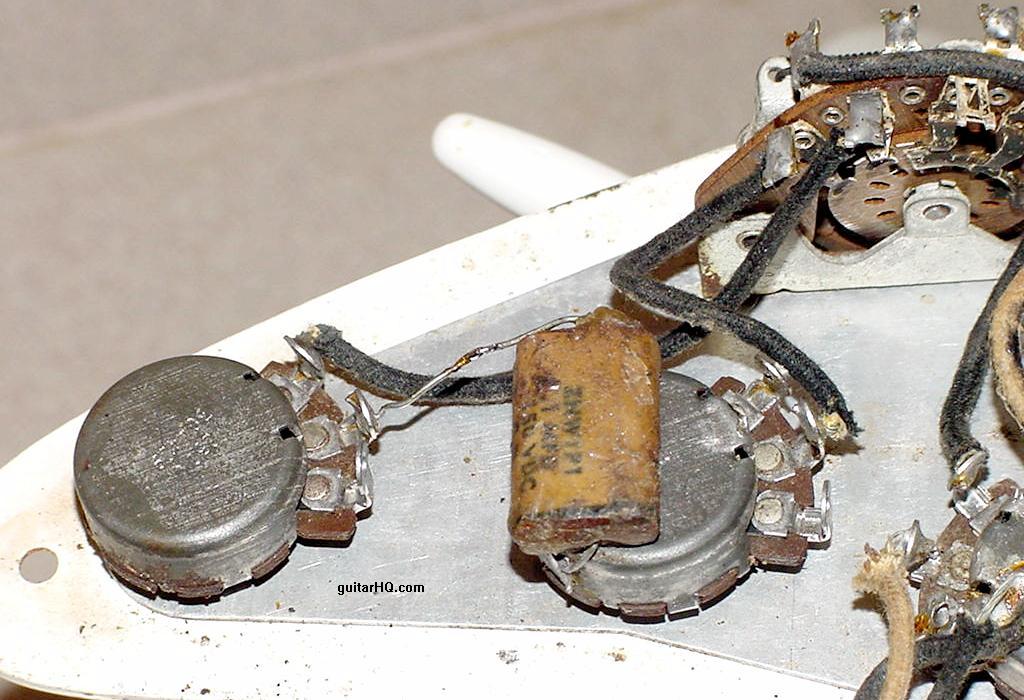 1955 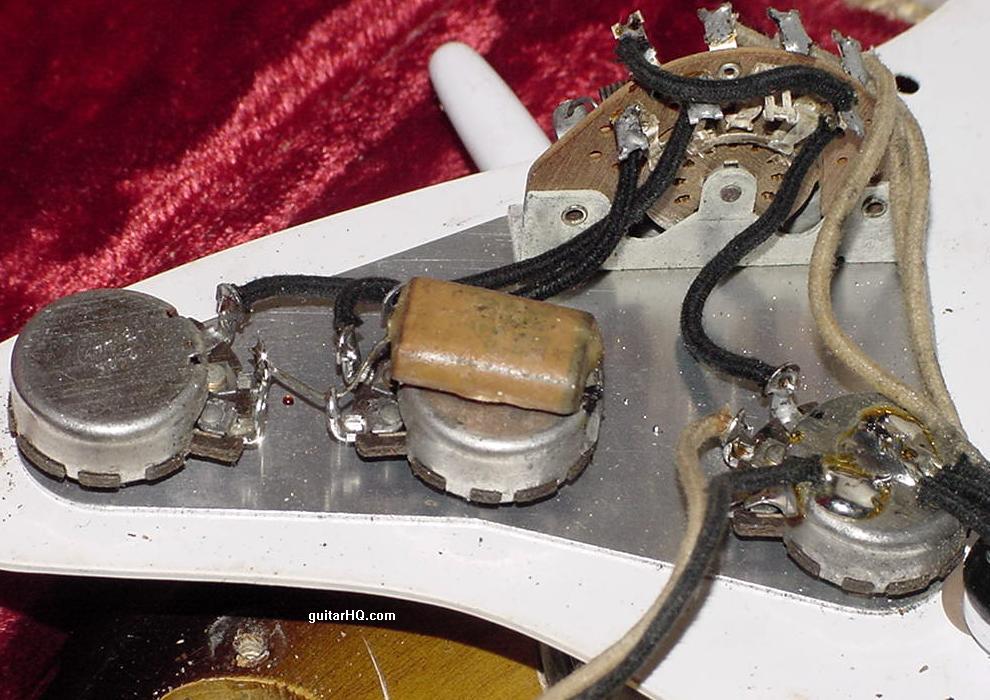 1956 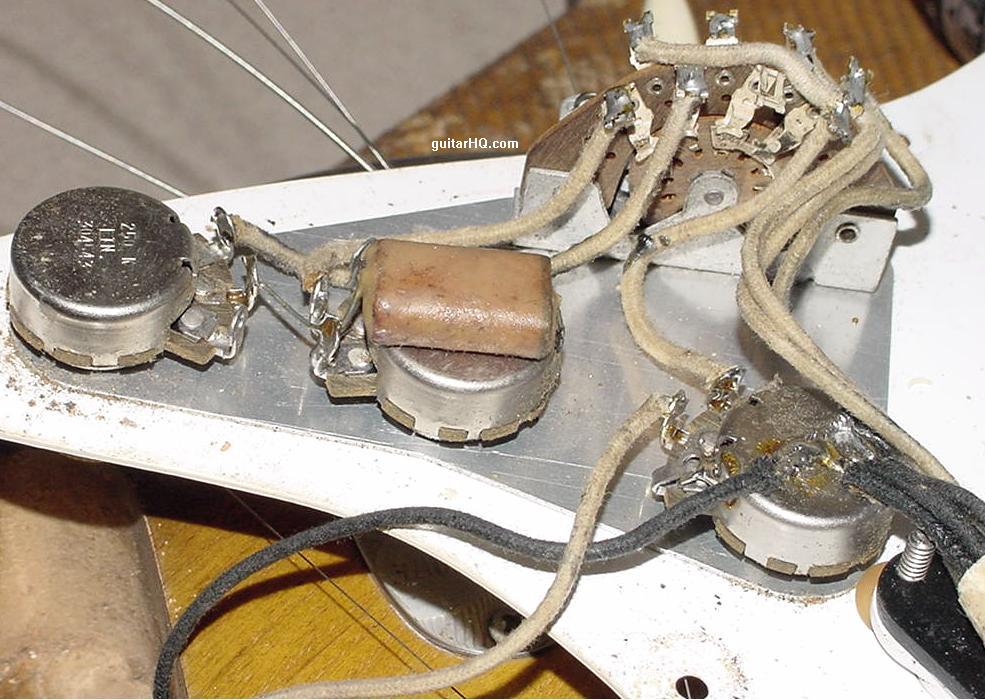 1957 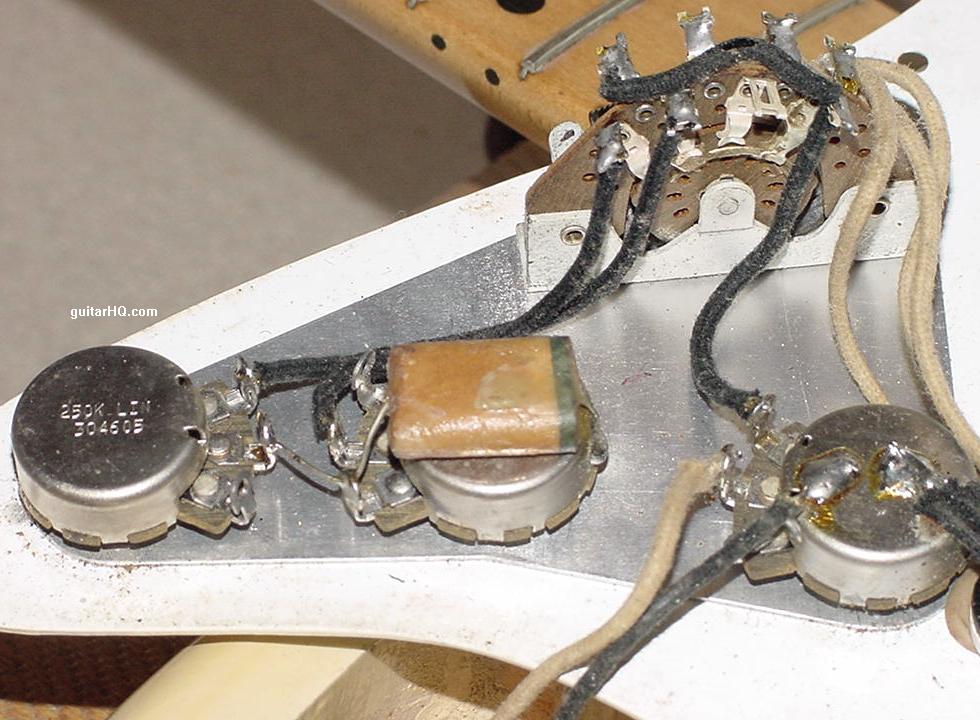 1959 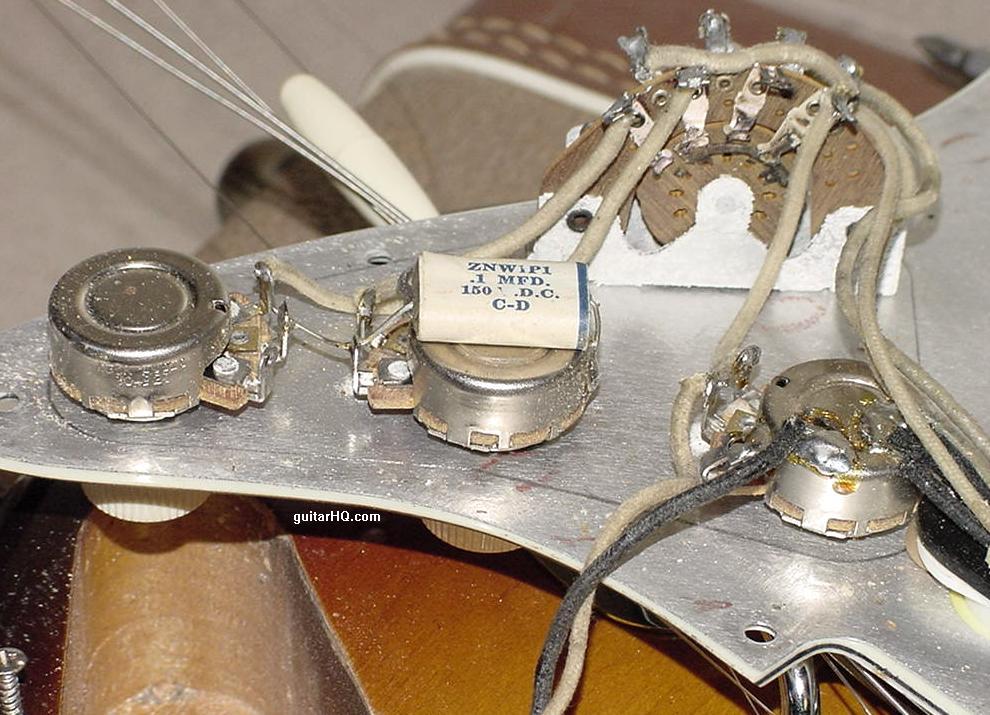 1961 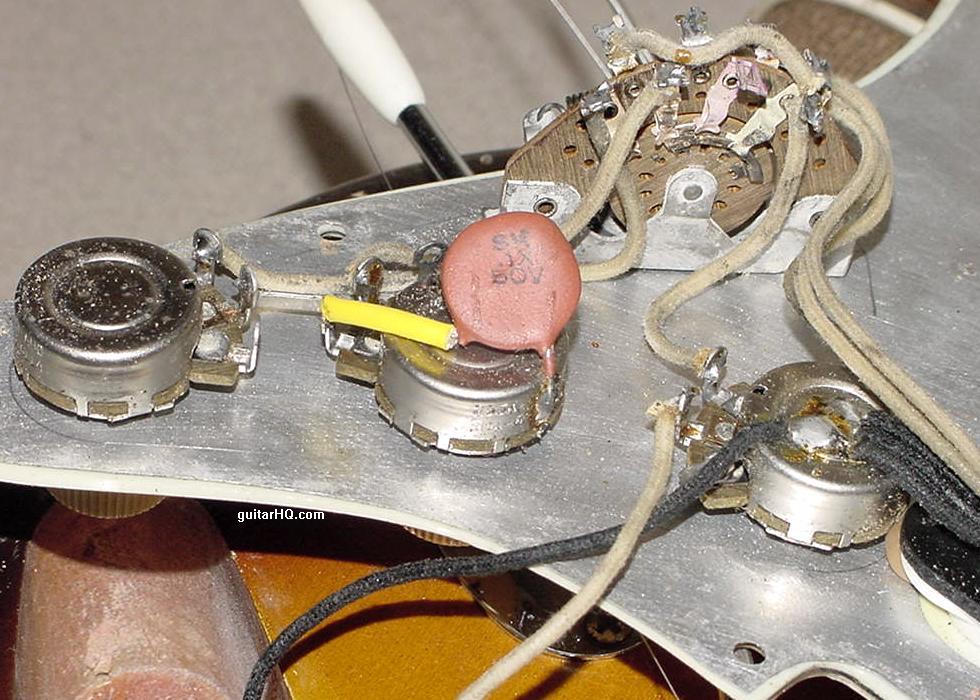 1962 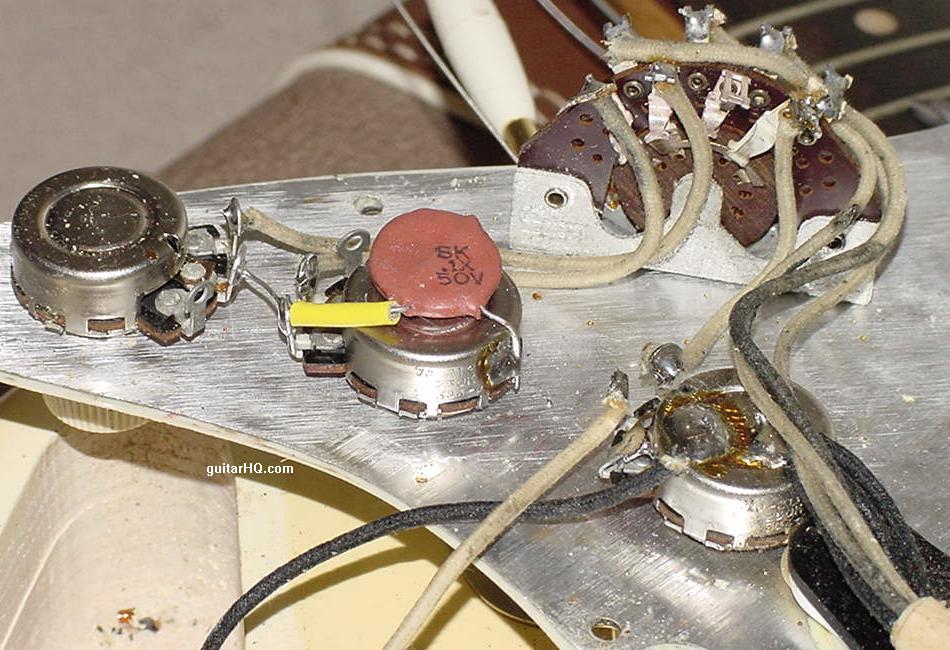 1963 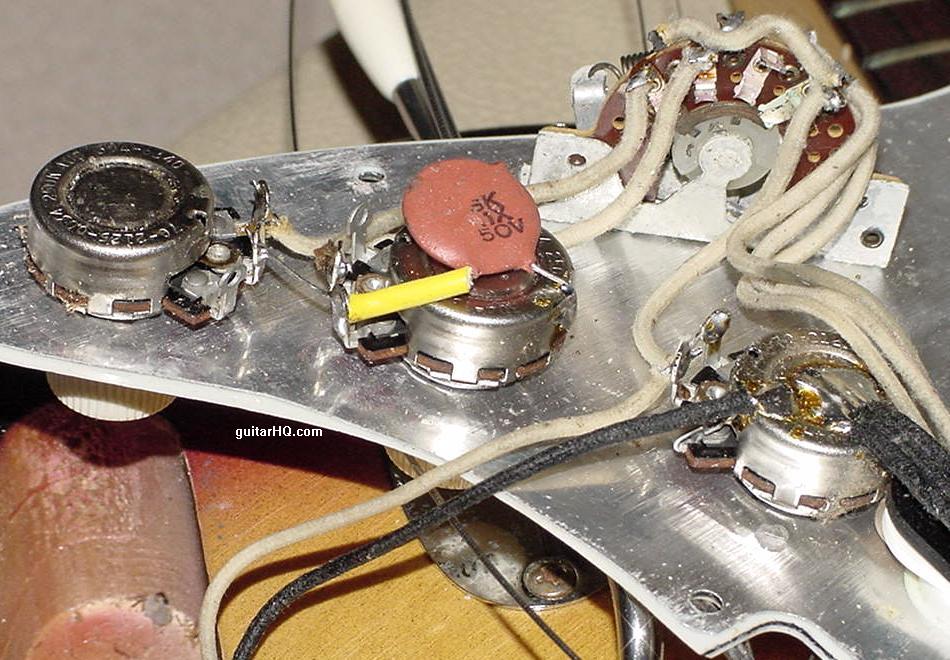 1965 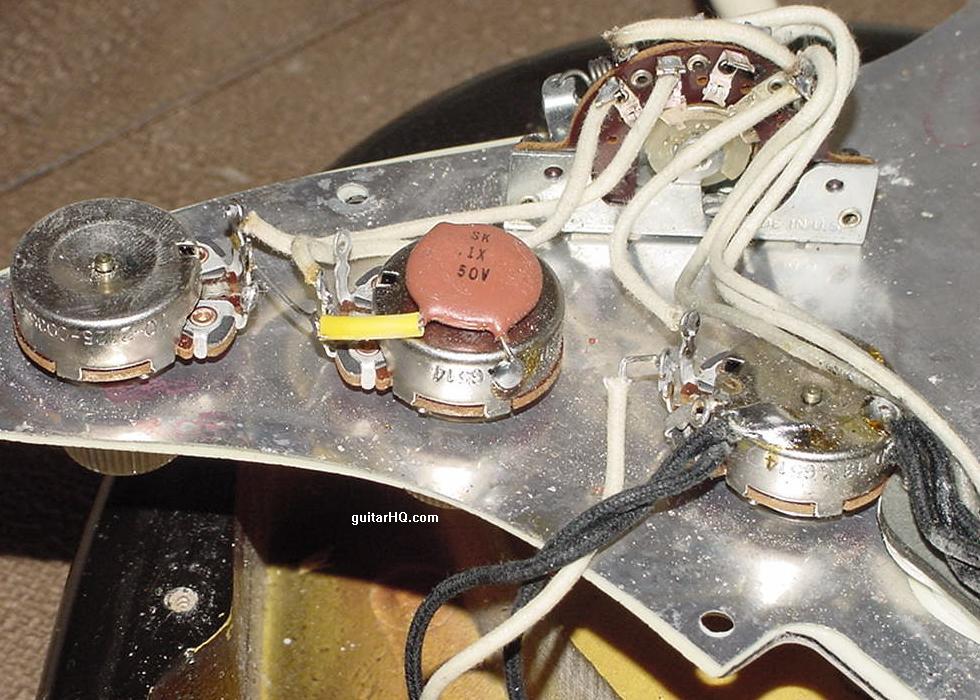 1966 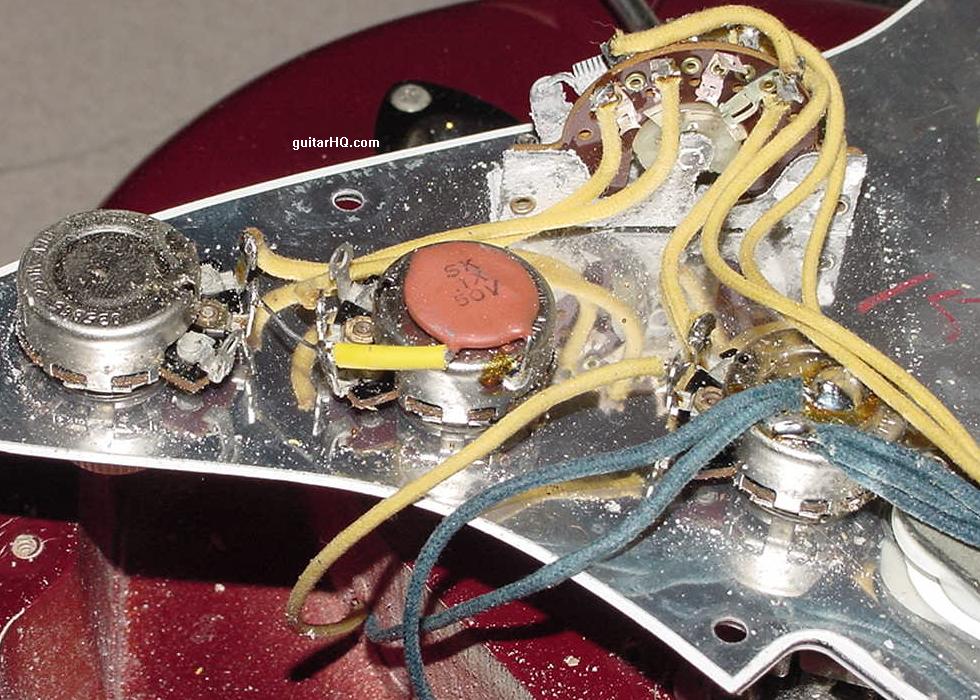 (I knew I was saving these things for a good reason! ;D) Long story short, you must keep in mind that Leo was first and foremost a Radio-TV repairman. He had on hand a stock of components that were best suited for these kinds of repairs. Knowing as he did just how they worked, he was able to transfer that knowledge over to guitar/amp building, and he kept things both simple and reliable by using the exact same parts - he simply upped his order quantities. Truly, that's it in a nutshell.  HTH sumgai
(EDIT: fat-fingered an extra letter in there, towards the end. Sigh.) |
|
|
|
Post by mr_sooty on Mar 21, 2012 14:39:56 GMT -5
I'm not sure if the 'variation between computers' argument is that relevant is it? I mean, yes we can assume that there may be some difference in what I hear given a different computer and different speakers or headphones, but we're each listening to all the different caps on our own computer through our own headphones, and presuming we're not changing headphones between caps, any changes we hear from one cap to the next would still be relevant.
I think of more relevance is the argument that the capacitance value will vary between the caps, especially when some are old components that have been sitting around for decades.
So I guess any benefits I got from changing the cap in my guitar were either imagined, or more likely, due to the fact that I changed from a .022uf cap to a .047uf one. I notice too that Leo's caps were all .1uf, when modern American Strats use .022uf. Would this explain in some part the difference in the tone of a vintage Strat (or even a vintage reissue) and an American Standard?
Does the tone cap value affect the sound of the guitar even when the tone control is wound right up (no treble roll off)?. Will some high frequencies still go to ground via the tone cap even when the tone control is not in use? The guy in the video doesn't really demonstrate this.
(This is the only forum I know where I can get so in depth and practical about this stuff!)
|
|
|
|
Post by reTrEaD on Mar 21, 2012 18:25:56 GMT -5
Will some high frequencies still go to ground via the tone cap even when the tone control is not in use? Yes. Does the tone cap value affect the sound of the guitar even when the tone control is wound right up (no treble roll off)?. Yes. But I think the difference would be very hard (or maybe impossible) to hear. If I have some time, I'll run a sim. |
|
|
|
Post by sumgai on Mar 21, 2012 19:05:13 GMT -5
sooty, Two things: Actually, there are more than half-dozen different "sound" chips out there, available for computer makers to choose from. Trust me, they don't all sound the same, given everything else is frozen. Cost would be your first clue on this issue..... Furthermore, when you are changing caps and testing, you're using your own equipment, eh? Presumably, your signal path is continuous from pickup to speaker, no computers were involved, right? If not, then you've introduced another variable that, while unchanged for your testing purposes, won't be present when you go on stage. (Presuming as well that you, like most players, don't use a laptop/other computer while performing live....) But regardless, what you hear, and if you recorded it, what you recorded will not be played back on the exact same equipment, so there will be a sonic difference. Things only go further South when you introduce indirect data transmission. That's where you send the file via a network, as versus just giving the recipient a CD/DVD/USB stick. If you placed it on a server, are you 100% positive that those foks didn't molest your data by compressing it save server space? And we can't forget those pesky transmsisison protocols themselves. You do realize that there are several compression protocols used to send data from one computer to another, don't you? (P2P or host/client, it doesn't matter.) Trust me, such protocols are used, because without them, we'd have no "common language" between our 'puters, and that'd make it pretty difficult to share stuff, eh? GZIP and Deflate are the two main protocols, but there are others. Can you be absolutely positive that these transmission-compression protocols left your data pristine, just as if you had mailed the recipient a CD/DVD/USB drive?  </end of first point> Second; We've discussed this before, here in the NutzHouse, and I've softened my position a bit since the last outing. No longer do I feel that you must attract your audience, regardless of what you like/want to hear, tone-wise. Now, I feel that if you aren't happy with your tone, your audience will somehow sense that unhappiness, and will not become totally involved with your stylings. IOW, it's a fine line you must walk, but the take-away is that you must walk it, no one else can do it for you. If that means $60 Humjob caps, be my guest! So long as you're happy, no one has any right to gain-say you, period. Third (OK, so I can't count - so sue me!  ); Leo also used 1MΩ pots in everything for the first several years, possibly longer than a decade ('51 to '61 or thereabouts). Only gradually did he step down to 250KΩ units, at about the same time he started installing lower value caps. Insofar as I can tell (and from what little I can recall of discussions at the time), this was all coordinated with the new line of amps, those with the control panels facing front instead of on top. New speaker designs, new cabinetry, lots of factors were considered in his components choices, certainly more of them than we'll ever know.  OK, that's my blowout for the day, it's now officially Miller Time! ;D HTH sumgai |
|
|
|
Post by mr_sooty on Mar 21, 2012 20:00:30 GMT -5
Sumgai, I think you missed the point of what I was trying to say re the computer thing. I'm not disputing that it will sound different from one computer to the next and all that. We're not watching this clip to hear 'exactly' what given cap will sound like in our guitar (different guitars too!). We're comparing between caps to see if we hear 'change'. It shouldn't matter if my computer set up sounds slightly different to yours, because I'm listening to all the caps on my computer, so they're all being played through the same computer - and if there's a noticeable difference between the caps, I should be able to hear it, even if the particular characteristics aren't replicated exactly.
I was more interested in whether you thought a guitar with a 0.022 tone cap would sound subtley different from one with a 0.1 tone cap even with the tone pot wound up full (no treble cut). I realise we're talking subtle here, this is cork sniffery type stuff, but in theory would it potentially make a tiny difference, even with the tone on full. reTrEad says yes.
|
|
|
|
Post by JohnH on Mar 21, 2012 21:30:24 GMT -5
my favorite speadsheet can now do comparisons of two response curves. Taking a guitar at full volume, tone at 10, and changing the tone cap from 0.022 to 0.1, I found a max difefrences of no more than 0.05db at any frequency up to 3.5kHz (1db being usually regarded as the samllest discenable difference), depending on what type of pickup and pot is used.
J
|
|
|
|
Post by mr_sooty on Mar 21, 2012 21:44:16 GMT -5
Interesting. So it seems that technically speaking, if I went out and bought an expensive .047 paper and oil cap and replaced my cheap .022 poly cap with it, and suddenly thought the tone of my guitar improved discernably, this would simply be a case of my brain telling my ears what to hear.  |
|
|
|
Post by sumgai on Mar 22, 2012 4:18:26 GMT -5
Sumgai, I think you missed the point of what I was trying to say re the computer thing. Perhaps. When all variables are "frozen", then I'd agree that any difference in caps should be audible (or not), and that same differentiation should be discernible to someone listening remotely to your recordings. Not always, but certainly more often than not. Despite what JohnH's spreadsheet says, I'll go with reTread. For reasons only Gawd knows, numbers don't always tell the whole story. Keep in mind, doing this cap mod on your guitar may produce a very subtle difference in tone, but doing it on your buddy's guitar may not - the Gawds are fickle about that!  HTH sumgai |
|
|
|
Post by mr_sooty on Mar 22, 2012 5:10:38 GMT -5
Oh well, I'm still fairly convinced my Strat sounds better than before. My ears are telling me that even though science is suggesting it's unlikely. The thing is I'm not usually particularly prone to snake oil solutions - though I'll try anything once. I tried one of those Callaham tremolo blocks a couple of years back (the difference is night and day, they say  ) and despite that being quite a bit more expensive than the capacitor in question, and a lot harder to get hold of, once I installed it I instantly wrote that one off as not having made any difference whatsoever and sold it on straight away. I've tried so many different pickups in this guitar and something never quite sounded right - I always put it down to a lack of resonance in the wood - but I could swear something is different after the cap change. It seems to have lost a little of it's cold clynical-ness. To me it sounds warmer and less ice-picky than it did before. We ask these questions and we debunk it with science and yet I go back and play it again and it still sounds better to me than it did. If it's a placebo, it's been an good one. It's made me like my Strat again. We'll see how long it lasts! ;D |
|
|
|
Post by reTrEaD on Mar 22, 2012 9:36:57 GMT -5
I was more interested in whether you thought a guitar with a 0.022 tone cap would sound subtley different from one with a 0.1 tone cap even with the tone pot wound up full (no treble cut). I realise we're talking subtle here, this is cork sniffery type stuff, but in theory would it potentially make a tiny difference, even with the tone on full. reTrEad says yes. Despite what JohnH's spreadsheet says, I'll go with reTread. For reasons only Gawd knows, numbers don't always tell the whole story. [/quote] I was cited twice, so I think it's time to go back to what I had said... Will some high frequencies still go to ground via the tone cap even when the tone control is not in use? Yes. I was remiss in mentioning that some of ALL frequencies will go to ground via the tone cap. Not just some of the high frequencies. At anything other than DC, a cap has a reactance that's less than infinity. But "some" doesn't have a specified value. Are we making an evaluation of "how much is some"? Or are we simply saying not-zero? Does the tone cap value affect the sound of the guitar even when the tone control is wound right up (no treble roll off)?. Yes. But I think the difference would be very hard (or maybe impossible) to hear. If I have some time, I'll run a sim. I ran the sims for values between 10nF (.01uF) and 100nF (.1nF) with a 1Meg, 500k, and 250k pot, each at full resistance. There was no discernible difference between the traces for varying cap values. Each trace fit wonderfully superimposed on the next. It wasn't until the pot resistance was reduced below 100k that I began to see an appreciable "blurring" of the line. At 50k, there was maybe 1dB of difference between the smallest and largest cap values. And the largest part of the differences was between 50Hz and 2500Hz. At higher frequencies, the traces merged back together. Given that, I'm inclined to lean more heavily toward "impossible" rather than "very hard" to hear. Thirdly, all the science and maths supports the idea that with a tone pot at 10, the cap makes a negligible difference, whatever the type or value is or even if it is a piece of wire, But the tone pot value does make a significant difference. So getting particular about caps seems only to be important if you like to turn down the tone, which some do but I tend not to. cheers John The sims definitely support that. While there was no discernible difference by varying the cap value, the difference caused by changing the resistance value (1M, 500k, 250k) was painfully obvious. Roughly 2dB between steps, about 4dB between the lowest and highest. And the differences were in the frequencies between 2500Hz and 7500Hz. If we do some quick maths, we can begin to understand why the cap has so little importance when the resistance is high. Let's take the smallest cap, since it will have the highest reactance. For a 10nF cap the reactance is 159k @ 100Hz 15.9k @ 1kHz 1.59k @ 10kHz In the region we're most interested (1kHz ~ 10kHz) the capacitive reactance is completely dwarfed by the resistance value of the pot at maximum resistance. Small cap, big cap, or dead short with a piece of wire, they're all relatively insignificant compared to the resistance of the pot. Oh well, I'm still fairly convinced my Strat sounds better than before. Maybe it does. Maybe something else changed at the same time. Or maybe it's all in your head. *shrug* |
|
|
|
Post by mr_sooty on Mar 22, 2012 17:52:58 GMT -5
Or maybe it's all in your head. *shrug* I'm totally open to that possibility. I wish I did a before and after recording actually. Half tempted to put the old one back in just to record it. |
|
|
|
Post by JohnH on Mar 22, 2012 20:49:37 GMT -5
reTreads numerical support of of my numerical support of what reTread supports, supports my supposition of his hypothesis.
So at least that is all clear.
I think there could be differences in the sound of cap types, when tone is rolled down, to the extent that real components are not the pure capacitors modelled, by will have variations and maybe extra leakage and inductance and other things. I cant see any mechanism for significant variations when the tone is at 10 however, and this is what the numbers are showing, and this would apply to almost any conceivable passive capacitor device in place of the tone cap, unless it had very much higher impedance than a normal tone cap.
But Im very glad that sootys new cap has turned a disliked guitar into a well liked one - money well spent IMO!
cheers
John
|
|
|
|
Post by reTrEaD on Mar 22, 2012 22:47:43 GMT -5
I think there could be differences in the sound of cap types, when tone is rolled down, to the extent that real components are not the pure capacitors modelled, by will have variations and maybe extra leakage and inductance and other things. Sure. When the tone control is rolled down, the situation changes dramatically. I'd lean more toward "other things" rather than leakage or inductance. In large electrolytic caps, there is are serious issues with inductance. But with caps of smaller sizes, I suspect the inductance would be quite meager. My gut is telling me inductance alone probably doesn't account for much. But inductance combined with "other things" might. In theory a capacitor has two parallel conductive plates separated by an insulator proximity and area govern the strength of the electric field and the capacitance. In reality, those plates are far from "parallel" at a microscopic level. The texture of the surface causes the device to act more like many small capacitors in parallel with each other. The regions that are closer in proximity are where the greatest capacitance is. Regions that are farther away are less significant. Not sure how it all fits together, but I think the microstructure of the surfaces plays a key role in any "sonic" differences. And I still reckon any abnormalities carry more weight when the cap is used for coupling, rather than shunting. I cant see any mechanism for significant variations when the tone is at 10 however, and this is what the numbers are showing, and this would apply to almost any conceivable passive capacitor device in place of the tone cap, unless it had very much higher impedance than a normal tone cap. If you have some time to kill, run some sims with smaller caps and "tone on 10". You might be somewhat surprised at the results. They'll make sense when you reason it out. But at first glance they seem odd because the lower frequencies are where differences between cap sizes are most apparent. |
|
|
|
Post by JohnH on Mar 23, 2012 1:36:56 GMT -5
Interesting, but Im not getting such an effect, so clue (or just answer)needed. What sort of cap values and what results do you find with this?
cheers
John
|
|
|
|
Post by reTrEaD on Mar 23, 2012 4:25:32 GMT -5
hmmm. I'm not seeing it now either. Dunno what I might have done before that was different.
|
|
|
|
Post by JohnH on Mar 23, 2012 4:33:40 GMT -5
hmmm. I'm not seeing it now either. Dunno what I might have done before that was different. Dont worry! Its that pesky 'Something Else' factor again. The one that electrical science put in the 'too hard' basket and so hasn't gotten to yet. It only happens with virgin Bumble-Bees removed from 60 year old NOS radiograms by Laotian monks on a lunar eclipse. Now I happen to have a box of them around here somewhere and I might be willing to part with a couple for the right price... J |
|
|
|
Post by jimmynitro64 on Aug 29, 2013 19:27:56 GMT -5
There seems to be a lot of b.s. about tone caps these days. Especially these " boutique" caps that are exspensive and superfluous. I found that radio shack caps of ,say .022 uf, does pretty much the same thing. If you consider that the tone pot is all the way up,what's it doing? Nothing. Unless you have no load pots. Or you have Eric Johnson ears. Even then you dealing with millivolts. How many people here a slight change in .1,000,000th of a volt? |
|
nikogo
Meter Reader 1st Class
   Passerby
Passerby
Posts: 51 
Likes: 0
|
Post by nikogo on Feb 23, 2015 20:19:08 GMT -5
My two cents into this old discussion.
Those big paper-in-oil capacitors have coiled conductive layers with multiple turns that for sure have much higher internal inductance than ceramic capacitors. The pickup with capacitor itself create an oscillatory contour for some nasty high frequency oscillations. But the internal inductance (that is smaller than in pickup) with capacitance has much higher resonant frequency and kills all the rest oscillations except the lowest ones. So it cleans the sound from harmonics up to fundamental wave. I believe, that makes paper/film-coiled capacitors a better choice for low frequency sound circuits.
|
|
|
|
Post by ourclarioncall on Feb 2, 2020 19:55:23 GMT -5
Thoughts on this ? Would it have any significant effect on guitar wiring ?
|
|
|
|
Post by sumgai on Feb 2, 2020 21:30:21 GMT -5
Seriously?  50 minutes to discuss allegedly backwards caps? !!!!!! 50 minutes to discuss allegedly backwards caps? !!!!!! 
I wasn't gonna even bother, but I thought "what the hey, I'm veggin' out at the dinner table, so what else have I got to lose?" Holy Jebus on a jumped-up Pogo Stick, that was a collosal harassment of electrons!
Now, here's the rub, and if he got into it after the 60 second mark, then shame on him - he should've said so within the first 10 seconds. (I made it to something like 17 or 18 seconds before hitting the Exit button.) The deal is that in most normal situations, the only capacitor type that is polarized is what we call an electrolytic. These are usually of large value, and are always found in power supply filtering sections. They "smooth" the ripple (small amounts of AC) found in the DC high voltage supply. (There's other stuff going on along side of this activity, so please don't yank my chain about "forgetting", I'm just keeping it simple.) Also, most tantalum caps are polarized, because they are actually small-value electrolytics. For reasons of capacitance value alone, we don't use electrolytics in tone control circuits. (Although I have seen it done in automotive stuff, where the buzz coming out of the alternator needs to be suppressed, right in the signal chain.)
I'd like to know what this joker was thinking, spending 50 minutes to tell us what could've been stated in 2, and fully explained using 28 color glossy photos with circles and arrows and a paragraph on the back of each one. On second thought, I don't need to be depressed, so no thanks, I doe nwanna know.
sumgai
|
|
|
|
Post by thetragichero on Feb 3, 2020 4:32:21 GMT -5
ain't gonna bother watching it but i know there's some amp guys who SWEAR that orienting the capacitor so that the outer foil (it what they perceive is the outer foil based on a line drawn on the capacitor) towards the position with the lowest impedance to ground results in less noise or somesuch. my thought is that between forming the cap and the silkscreen, what's to say that it doesn't flip around? to me it's what y'all refer to as "feldergarb." but i suppose there's already a ton of nonsense wrt to capacitors in guitars (spending DOLLARS on guitar tone caps and whatnot. i have purchased 100v orange Sprague caps for looks but ain't no different than your standard ceramic or chiclet cap. to me it seems as if we almost want to believe that there's some sort of mojo voodoo in these things. i remain skeptical
|
|
|
|
Post by newey on Feb 3, 2020 6:50:22 GMT -5
And, rightly so. One thing that never seems to be mentioned in these discussions is that the manufacturer of these components probably knows more about their product and its uses than a guy in a YouTube video. Manufacturers want satisfied customers who will come back for repeat business. So, if there truly was a difference in the orientation of non-electrolytic caps (and non-tantalum ones), wouldn't we expect, first and foremost, that at least one of the manufacturers would have discovered this effect, and then told buyers how to properly use the product the "right way around"?
The fact that no manufacturers do so should set a high bar in everyone's mind for contrariness.
|
|
|
|
Post by reTrEaD on Feb 3, 2020 10:00:37 GMT -5
Yes. And they run contrary to the other replies. I'm amused by the pushback against facts, even trivial facts, when hearing less than 1% of the content. Would it have any significant effect on guitar wiring ? Effect? Yes. Significant? Not-so-much. I guess it all depends on how low you set the threshold for 'significant'. Would it make a 'significant' difference to make a wire connection that spans 4 inches in shielded cable rather than plain wire? I would say no, but YMMV. Would I, personally, wire a film cap with the end connected to the outer foil to the low impedance end of the circuit, if I already knew which end was which? Absolutely. Would I invest any time, money, or effort into determining which end was which, if it wasn't known? In a guitar, probably not. If I was building a high-end tube amp, definitely yes. Context matters. And since the author of that video was focused on tube amplifiers, not guitar wiring, it seems highly inappropriate to me, to dismiss his work just because it bears less significance in guitar wiring. Also ... Where To Connect the Outside Foil on Capacitors |
|
|
|
Post by sumgai on Feb 3, 2020 12:04:51 GMT -5
Oh, that was righteously funny, 'TrEaD, thanks for the guffaw!
Listen guys, this nonsense doesn't even play out in the laboratory, it's so inane. Call me an old fossil who can't accept "new think" stuff like this, but you'd be wrong. I can accept challenges to what's been tried and found true, but you've got to go through the same hoops as the old-timers did - all you gotta do is prove it, and I'll buy it. And if we're gonna start in on "context", then tell me... where do we use a capacitor that isn't already in a metal chassis/cage that's acting as a shield anyways, hmmmm? Esoteric wooden cabinets maybe?
This all plays to Aiken's misuse of "electrical field". It's an electrostatic field, and it would have to be powerful enough to induce a lot of other problems, if it were to influence a capacitor so easily. In point of fact, I believe this kind of thinking comes about from the old days (the ones I seem to like so much) where a single-layer capacitor was built to create an electrostatic field. (Look up Volta's electrophorus machine.) But by today's standards, those machinations of old produced mountains of static electricity, something that modern circuitry does not do, tube or solid state.
This is one of the reasons I don't respect Aiken so much. He's not an out-and-out nutjob, but he's locked into some cockamamie theories like this, and he can't prove them to be true - it's all conjecture, and that's pretty much a no-no in my book.
Oh, and why do manufacturers do things like mark the ends to indicate the "outer foil"? Because rubes will spend more money on such "sagacity". What company doesn't like more money?  newey's correct, if this were a real thing, every manufacturer and his banker would be hounding the catalog printers to include these things, touting them as a cure for all things evil. Reminds me of a snake oil salesman. I'm pretty good at detecting such people, but the wife's BS meter makes me look like a country bumpkin. She's clear over there in her chair, not even reading this thread, and now she's objecting to the fishy-smell coming out of my computer! newey's correct, if this were a real thing, every manufacturer and his banker would be hounding the catalog printers to include these things, touting them as a cure for all things evil. Reminds me of a snake oil salesman. I'm pretty good at detecting such people, but the wife's BS meter makes me look like a country bumpkin. She's clear over there in her chair, not even reading this thread, and now she's objecting to the fishy-smell coming out of my computer!
I'm done. Wake me when someone can actually prove the claims made so far in this thread. And by that I mean, a double-blind test with at least a 100 person sample rate.
sumgai
|
|
|
|
Post by reTrEaD on Feb 3, 2020 13:26:40 GMT -5
This all plays to Aiken's misuse of "electrical field". It's an electrostatic field Is it? Or is he talking about an electro magnetic field? Instead of just dismissing someone because they used a tiny bit of terminology that's not quite Kosher, you might want to look at the gist of what they're saying. This is one of the reasons I don't respect Aiken so much. There are rare few people I trust implicitly on the internet. R.G.Keen, John Hewitt, and yes ... Randall Aiken. It will take more than a tiny lapse in terminology to shake my respect for any of them. Listen guys, this nonsense doesn't even play out in the laboratory, it's so inane. Instead of tilting at windmills, Mr Quixote, why not just watch the video? The proof of validity you insist upon is already there! He proves it with the big ol' bucket of noise, right before your very eyes. I could spoon-feed it to you by telling you the timestamp, but I won't. Seriously people ... what the heck am I witnessing here in the replies? At least two of you have readily admitted to not watching the video but you're passing judgment on it? How do you even know what's been said if you haven't even heard it? This is one of the most shameful moments I've ever witnessed on GN2. If you want to bury your heads in the sand, so be it. But it won't come without dissent from me. |
|
|
|
Post by sumgai on Feb 3, 2020 21:19:45 GMT -5
reTrEaD,
I have never felt ashamed at dismissing FelderGarb, be it from a company or an individual. Even, when... no, especially when there's no money involved, I still look behind the curtains. If what I see is BS, then I don't waste what little time I have left on this ball of dirt.
Aiken isn't a complete idiot, but we all have our blind spots, and this is one of his. And yes, I did consider an electromagnetic field in place of electric, but that doesn't wash either. Whereas electrostatic does wash, when it comes to capacitors. (Again, see Volta and his machinations.) So why did I make that distinction? Simple - copper foil (and most other types of metal) tend to block electromagnetic radiation, as proven in our very own shielding efforts. Caps that are not made with any metal conductors may be more prone to suffering under a electromagnetic field, but I'd still wager that such a field would have to be pretty intense before the effects would be noticible to any signal passing through. Actually, that goes for any cap, of any construction.
But if he's speaking to an electrostatic field, then yes, he could be on to something. No, I haven't started speaking with a forked tongue, I'm merely admitting that he wouldn't be going off the deep end in the wrong pool. I'm only stating that his pool water is tainted.... there's a difference.
I remain firm - the intensity of any such field that could possibly affect a capacitor's operation would be so large that many/most/all other nearby components would also be affected. Such a disruption would not be small, it would be of a size that no one could abide by it.
And right about here, I have to admit to something: I've taken it that a field disrupts a capacitor's efforts by some noticibly large amount. That's not what Aiken is saying. R.A. says that some particular kind of electrically based field could possibly induce a bit on noise, or hum, into a signal passing through a capacitor if the cap is connected the "wrong" way around. I could translate that as "a cap might fend off interference more easily if it is hooked up a certain way", going on to mean that the outer foil would be the logical choice to get this result. And I still say hogwash - a cap's job is not to deny entry to noise or hum - that's the job of the surrounding Faraday cage. If that cage isn't doing it's job correctly, then you've got other, bigger problems to contend with. And neither pulling on one's hair, nor beating one's self on the chest ala Tarzan, nor swapping cap leads is gonna fix it, trust me.
As for proof, I'll just reiterate my mantra - show me a lab-grade double-blind test with at least 100 persons observing the results, and I might change my mind. Otherwise, I'll continue to enjoy my own blind spots, TYVM. 
sumgai
|
|